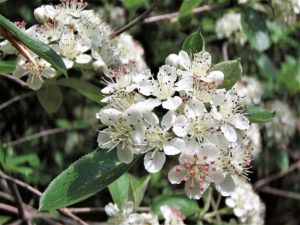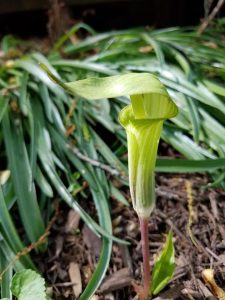Plant Profiles
A Parasitic Lifestyle: Beechdrops and Their Relatives
By Marion Lobstein Two primary characteristics of plants are a light-capturing pigment, chlorophyll, which gives most plants a green color, and the use of this pigment to capture light energy to carry out photosynthesis to produce energy-rich food from carbon dioxide and water. This kind of plant lifestyle is known as autotrophic or self-nourishing. Indian…
Read MoreRed Chokeberry Shines in All Seasons
By Betsy Washington, Northern Neck Chapter Red Chokeberry (Aronia arbutifolia) is a versatile landscape shrub that shines in all four seasons of the year. In spring, showy clusters of up to 25 pristine white, or pink-blushed flowers light up the garden. Throughout summer the foliage is a lustrous dark green, then ignites in fall with shades…
Read MoreGoldenrod Glows in the Fall
By Richard Stromberg Along with Asters, Goldenrods are the dominant flowers in September. Some of them continue flowering into October, and you will see their fluffy seed heads all winter. Goldenrods have small-flowered, yellow spikes and sprays. Twenty goldenrod species are frequent in the Piedmont Chapter area. Note that the large leaves at the base…
Read MoreThe Pipevine Swallowtail Butterfly and its Native Host Plants
By Mary Lee Epps, Jefferson Chapter I decided to write this article for our chapter Newsletter, The Declaration, because of an experience I had two years ago. On a family outing to the Dripping Rock area of the Blue Ridge Parkway, we explored a trail that leads from the west side of the Parkway. After…
Read MoreAll About the Stamens
By Betty Truax, Jefferson Chapter Years ago, when I lived in Northern Virginia, my mom gave me a Mock Orange plant that had no scent. It was a shared plant from her friend Anna Davis in Rochelle, Virginia. The plant was important to my mom because it reminded her of being young. With this particular…
Read MorePurple Passionflower Pops in Summer
By Betsy Washington, Northern Neck Chapter Driving along sandy roadsides and fields of the coastal plain in summer, it is always a delight to find our native Purple Passionflower (Passiflora incarnata), a deciduous vine with dark green, three-lobed leaves and exquisite, showy flowers and edible fruit. This vigorous vine is native to the southeastern United…
Read MoreDowny Lobelia: An Overlooked Garden Native
By Betsy Washington Several of our native Lobelias are well loved and absolutely beautiful. Cardinal Flower with its brilliant red flower spikes, and Great Blue Lobelia with its crowded spires of deep blue flowers, are familiar to many gardeners. Downy Lobelia (Lobelia puberula), which is less well-known, graces roadside ditches, low and upland woods, riverbanks…
Read MorePawpaws And The Zebra Swallowtail Butterfly
By Mary Lee Epps Pawpaws have a great deal to offer—handsome flowers in the spring, delicious and highly nutritious fruit in the early fall, plus they are the only host plant of one of our most beautiful butterflies, the zebra swallowtail. Our pawpaw (Asimina triloba) is the northernmost member of the mostly tropical Annonaceae (or…
Read MoreJack-in-the-Pulpit Preaches Preservation
Unlike many wildflowers that make a beautiful but brief spring appearance, the perennial Jack-in-the-pulpit (Arisaema triphyllum) appears later in April and continues to add interest to moist woodlands until late fall. The hooded inflorescence which resembles a pulpit (a spathe) has a “Jack” (a spadix) standing in the center as if delivering a sermon. Perhaps…
Read MoreThere Really is a Pyxie-moss!
Pyxie-moss (Pyxidanthera barbulata) is a diminutive coastal plain endemic found only in the eastern portions of the Carolinas, southeastern Virginia, and the pine barrens of New Jersey and adjacent Long Island. It is adapted to frequent fire and minimizes heat damage by forming dense mats that hug the relatively cool ground. It prefers open, sandy…
Read More









